– 1 – © Copyright 2013, Advisor Perspectives, Inc. All rights reserved. The Price America Pays for Global Leadership
By Bob Veres
December 24, 2013
America’s political debates inevitably default to finding ways to contain our federal deficits, and our investment debates focus on whether we’re facing a secular bear or bull market – and how to maneuver within that environment. I had never imagined that these two debates could be related until I heard a presentation by Bill O’Grady, of Confluence Investment Management in St. Louis, MO at the Insider’s Forum conference in Dallas.
Not only did O’Grady connect two very different discussions under a single umbrella economic framework; he made a persuasive case that persistent deficits are the price America pays for functioning as the global economic and military superpower.
America is now standing in the breach of preventing a global financial meltdown, according to O’Grady. He laid out the stark choices our policymakers face. But, first, let’s look at the economic framework he used to develop his thesis.
Navigating the bears
O’Grady is not your typical investment manager. He has a Master’s degree in economics, but his undergraduate work at St. Louis University was in history, and his partner (and co‐author of the presentation), Mark Keller, has an undergraduate degree in archeology. O’Grady also has an unusually broad investment perspective, having served as chief investment strategist for Wachovia Securities, also managing its Global Macro Asset Allocation program. Before that, he served the chief global investment strategist and assistant director of market analysis at A. G. Edwards.
The goal of his presentation was to provide not just an investment overview, but a big picture assessment of the forces that are driving the global investment markets, and some of the how and why. As an aside, he said that communicating the big picture may be the best way to alleviate a growing anxiety among advisor clients. “One of the things that has continually come up when we talk with advisors,” O’Grady told the audience, “is that their clients are unsettled. They cannot get their arms around what they’re afraid of, but they are afraid.”
O’Grady started by showing a chart of the movements of U.S. large‐cap stocks going back to 1870, using data provided by Haver Analytics and Robert Shiller.
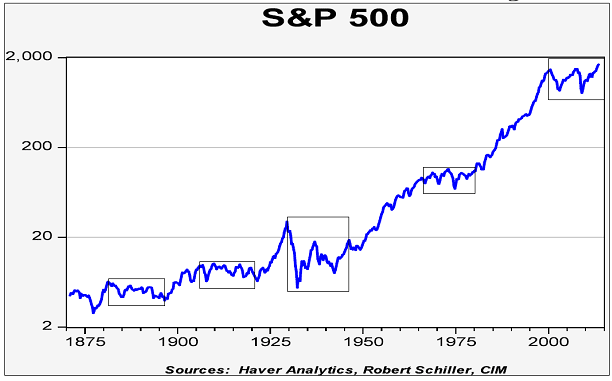
He then drew a box around five secular bear markets. The areas outside the boxes provided average gains of 12% a year. Inside the secular bear boxes, gains averaged 2% a year, with roughly the same number of up years as down years. Later, the audience was shown a graph of the annual returns during bear markets, and they lined up surprisingly well into a bell curve.

The point? “It is very important to know what kind of market you’re in if you’re going to be investing in stocks,” O’Grady told the audience. “In secular bull markets, you buy and hold, and indexing works great. You buy every dip and focus on growth. In secular bears, you have to rebalance frequently, you definitely need fixed income in your portfolio to act as a buffer, and you want to focus on value and dividends.”
Shifting sentiment
But, of course, that begs the question: How do you know when you’re in a secular bull or bear market? This is actually more difficult than it appears. O’Grady invited those of us with gray hair to think back to 1982, when nobody could be convinced to buy stocks at the beginning of the greatest bull market in history, or the tail end of the 1990s, when everybody thought the market would never go down.
In both cases, and everywhere in between, the difference between a bull and a bear is surprisingly not found in the underlying economic growth of the economy or growth in profits, both of which are similar during the bull and bear periods. “In secular bulls, the market goes up because the P/E goes up,” O’Grady said. “In the secular bears, the P/Es contract and the market goes sideways. What we’re willing to pay for earnings depends on sentiment.”
The numbers bear this out, although one could question whether O’Grady has sufficiently distinguished between cause and effect. – 4 – © Copyright 2013, Advisor Perspectives, Inc. All rights reserved.
O’Grady told the audience that during bull markets, American presidents averaged a 57.1% approval rating, while during bears the approval rating averaged just 49%. The consumer sentiment index compiled by researchers at the University of Michigan averages 79.2 during bear markets and 92.3 during the secular bulls.
But what drives consumer sentiment? Broadly speaking, O’Grady said, the answer is certainty – or uncertainty about global political leadership. Looking at the three modern secular bear markets, he found that they were surprisingly correlated with broad geopolitical forces. In the first of the three – what we have come to know as the Great Depression – the world was feeling its way through a global power vacuum. The U.K.’s role as the dominant global superpower had waned, and the world’s largest economy was the U.S. But America had a strong history as an isolationist state, and refused to assume the mantle of world leader.
“In periods where the superpower is in decline, the world becomes a dangerous and confusing place,” O’Grady told the audience. “The world was without a governor, and it fell first into depression and then tumbled into the Second World War.”
The second secular bear, O’Grady said, had its roots in what he called the “equality policy” in American political economics. “The goal, after the world had been ravaged by two world wars, was to create an economy that provided social equality and steady growth in jobs,” he said. Up through the 1970s and into the Reagan Administration, the U.S. government imposed extremely high tax rates, which had the effect of discouraging innovation and stifling entrepreneurship, since any risky enterprise that succeeded would have 90% of its windfall revenues taxed away to Uncle Sam. Why take the risk for no reward? The result was a hothouse environment for massive monopolies and oligopolies – large, powerful corporations and large labor unions. The tax money, meanwhile, created a broad social safety net: Social Security, Medicare, Medicaid, welfare and food stamps.
“During that era, we dampened the creative destructive element of capitalism, and it was very effective,” O’Grady said. “But it didn’t work because the equality policy became inflationary, and repeated policy stimuli led to a wage‐inflation cycle. Business productivity absolutely plummeted.” He showed a chart tracking the real output per hour of workers during this era, and it looks like a bear market graph of stocks.
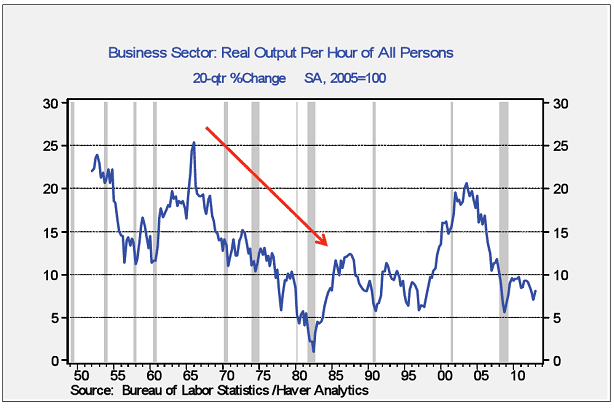
Welcome to the 1965‐1982 secular bear market
In O’Grady’s view, the inflation problem was solved primarily by a drastic reduction in tax rates, engineered during the Reagan Administration, which opened up incentives to entrepreneurship. Suddenly new technologies poured into the economy, AT&T was broken up, Japanese imports were allowed – and the wealth created by new ventures drove increasing income disparities between the wealthy and the middle class. The same chart (above) shows that after the Reagan tax cuts, productivity – measured in output per hour in inflation‐adjusted dollars – took off.
So too, did the bull market.
The curse of the reserve currency
Neither the equality policy nor the opening up to entrepreneurship solved the underlying problem which O’Grady said even government economists didn’t quite grasp: the burden the American dollar’s role as the reserve currency places on the U.S. economy as a whole. In simple terms, O’Grady said that the country that issues the world’s reserve currency has to chronically, systematically, consume more foreign goods and services than it sells to the world, creating a persistent, incurable trade deficit that can only go away if the country loses reserve‐currency status. At the same time, the global leader has to outspend the world on military technology and infrastructure, creating a persistent financial drag on the government’s finances. – 6 – © Copyright 2013, Advisor Perspectives, Inc. All rights reserved.
The second problem is easily understood, since reserve‐currency status confers responsibility for protecting trade routes, which requires a strong military. But why should the reserve currency burden its issuer with a chronic trade deficit? In other words, why is the U.S. economy effectively exporting a percentage of its consumption (and wealth) to other countries, and what ramifications does this have for tax and trade policies?
By way of explanation, O’Grady told a simple story. Suppose the citizens of Paraguay want to buy a ton of cocoa beans from producers in the Ivory Coast. The farmers in the Ivory Coast are happy to oblige, and they set a price of $1,200 a ton. The citizens of Paraguay naturally prefer to pay for the cocoa beans in its own currency, the guarani, but the producers in the Ivory Coast aren’t sure they will be able to use Paraguay’s currency to buy the things they want to own on the foreign markets. They want dollars, which everybody accepts.
So the Paraguayans have to come up with dollars in order to conduct trade with their neighboring countries – and everybody else as well.
Paraguay and the Ivory Coast are not alone. O’Grady cited statistics showing that 84.6% of all international trade letters of credit are denominated in dollars. Every country needs to get its hands on dollars in order to facilitate purchases and sales with the rest of the global economy.
Where do they get those dollars? They have to run a trade surplus with the U.S. economy. This was O’Grady’s punch line, and the explanation of the burden that the U.S. economy is carrying on its back. “When you provide the global reserve currency, you become the global importer of last resort and the champion of free trade,” O’Grady told the audience, “because the world needs your currency to conduct business.” Later, he noted that if the U.S. ever runs a trade surplus, there is a global contraction of credit – something the world economy cannot afford.
Trade deficits are the price Americans pay for the ability to ensure the continuation of free trade and global stability, both of which undeniably benefit American consumers and pretty much everybody else. “If we are trading with each other, we are less likely to shoot each other,” O’Grady said. “And the U.S. acts as the global market stabilizer, organizing bailouts for Mexico during the peso crisis, for Asia during the Asian Contagion, for Russia during its debt crisis. We help these countries recover through support of both investment and trade, and we want to have economic dominance to ensure compliance with global economic law.” Follow this logic, and you can see how U.S. sanctions eventually brought even Iran to the negotiating table.
Empire economics
O’Grady called this period after World War II the “empire” phase of our nation’s history, distinct from the prior “republic” phase, when we were free to grow without having global obligations. The burdens of empire were relatively light immediately after World War II, when the U.S. economy represented 36% of the global GDP. Today, as other nations are expanding their economic activity much faster than the U.S., – 7 – © Copyright 2013, Advisor Perspectives, Inc. All rights reserved.
and our share of global GDP has fallen to around 17%, the burden of being the consumer market of last resort has become considerably heavier.
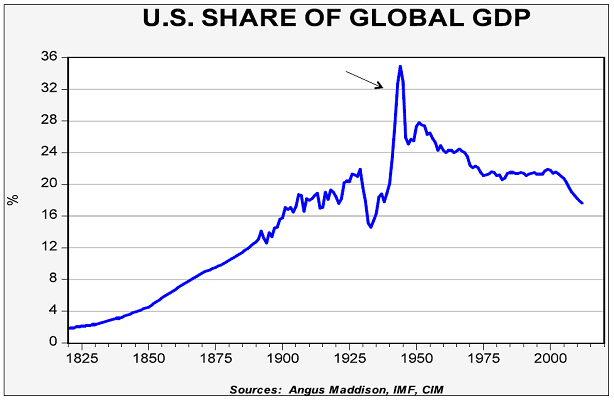
So, too, has the burden of projecting military power to all corners of the planet. O’Grady showed a chart which illustrated that since 1945, the U.S. has spent an average of 7.2% of its GDP on military forces, compared with 1% or less for most other developed nations.
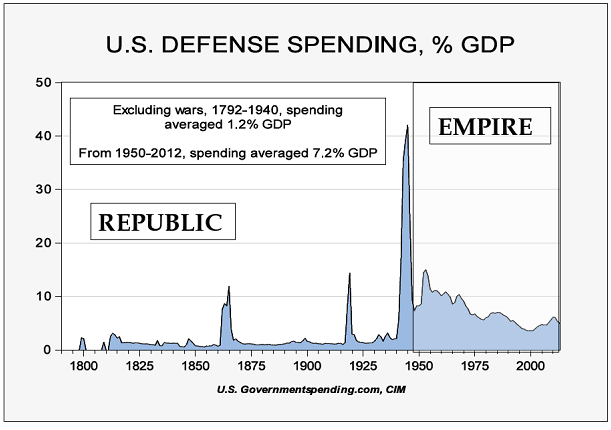
O’Grady then offered a chart which indicated that as the U.S. assumed the burden of empire – that is, of global economic and military leadership – its government deficits became persistent, and then ultimately larger and larger.
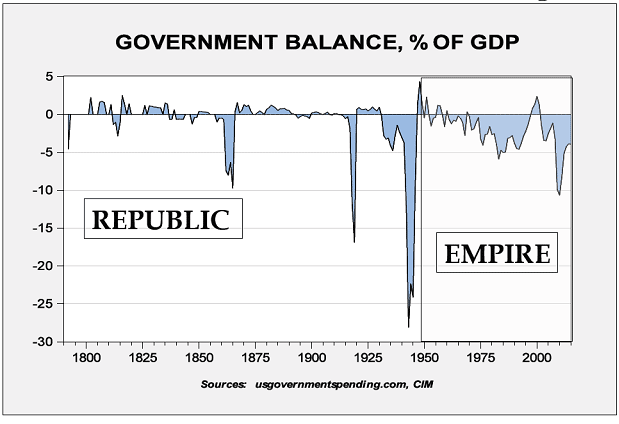
This, of course, could not be sustained, and O’Grady said that the 2008 collapse was, in part, brought about by a combination of unsustainable government debt and decades of consumers spending beyond their means by leveraging their homes and other assets in order to keep consuming.
Which brings us to today. O’Grady said that despite the run‐up over the last four years, we have been in a secular bear market since 2000, and you can see it in the depressed sentiment and a P/E ratio that is lower than the market P/E in 1990. Since 2000, the P/E ratio has fallen from 45 to less than 19 today – clearly not indicative of bull market sentiment.
Intractable challenges?
With this background, we can start to see the outlines of the problem that America will have to resolve before the markets can return to bull market sentiment – which also happens to be the tangible source of that nameless fear that clients are experiencing and bringing to your office. “America took on these levels of debt, not because we’re spendthrifts, not because we’re undisciplined, and not because we don’t know what we’re doing,” O’Grady said. “This is what a superpower has to do. This is its job. And what is even more disconcerting is that as we have delevered here in the U.S., global trade growth has pretty much stopped.” A chart comparing global trade as a percentage of U.S. GDP to U.S. debt as a percentage of GDP bears this out – unfortunately.
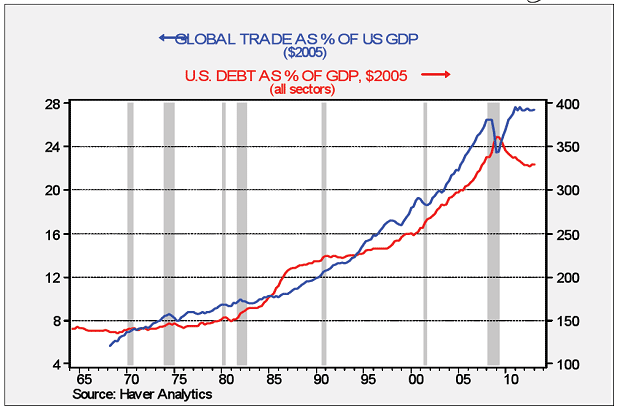
The question going forward, O’Grady said, can be phrased as: Can U.S. policymakers create an economy that can consume enough to meet the global demands of the reserve currency and ensure global compliance with trade agreements, without inflation or debt, and have a large enough military to police the world – and still maintain a sustainable fiscal policy, and do all this in a politically‐acceptable fashion?
“That is why the secular bear lives on, because there is no clear policy mix that can move us forward,” O’Grady told the audience.
There are options, however, and O’Grady offered them. The U.S. could scale back its military presence, limit defense spending to a more affordable 1% of GDP, and take a real stab at balancing its federal budget. But that would require other nations (think: China) to start taking on a larger role in defining global policy and policing international conflict. Best case scenario: Chinese domination of Asia and perhaps the Middle East and Africa.
The U.S. could walk away from its role as the provider of the global reserve currency, and eliminate its trade imbalances. But that would leave an economic power vacuum similar to the one that led to World War II. Best case scenario: Global trade collapses, regional conflicts ensue, and businesses move from just‐in‐time inventories to just‐in‐case supply chains. – 11 – © Copyright 2013, Advisor Perspectives, Inc. All rights reserved.
Or we can continue as we have been, but with our eyes open, recognizing that maintaining the American “empire” is an expensive undertaking, and political cries to balance the budget or eliminate the trade deficits are naive and anti‐empire sentiments.
“Either way,” O’Grady told the audience, “the people in our country need to have a frank discussion about this superpower role. Do we want to do it? Can we afford not to? And how are we going to accomplish it going forward?”
His conclusion: Until you hear that discussion in the political arena, until you hear a credible solution to the various dilemmas that the superpower role has left us with, invest as if you are navigating a secular bear market.






